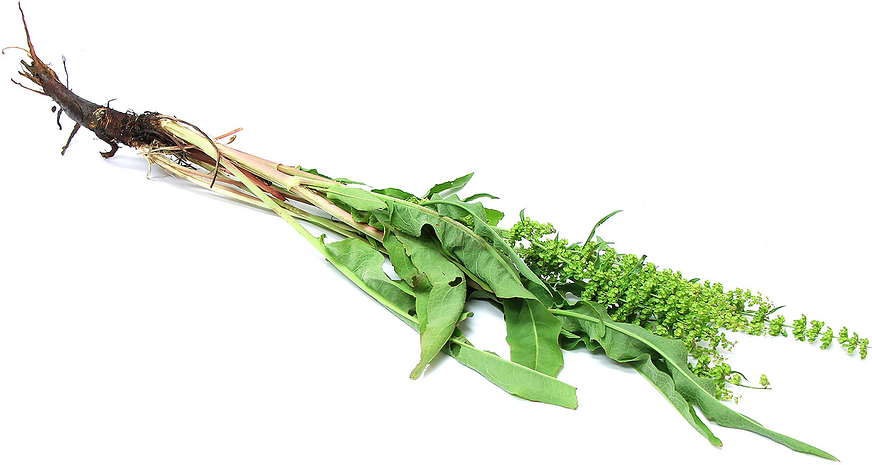


Foraged Curly Dock (Wild Rhubarb)
Estimated Inventory, lb : 0
Description/Taste
Curly Dock is a large plant with leaves and stalks that resemble traditional rhubarb. Its leaves are typically more elongated and narrower than those of common rhubarb and have wavy or curled edges, hence the name "Curly Dock." The stalks are slender and often greenish or reddish-brown. The leaves of Curly Dock are deep green and lance-shaped with wavy margins. The flower stalks can turn a rust color, and the seeds are tiny, hard, and dark, developing a brownish-red color when ripe. Curly Dock has a mildly earthy smell, which may intensify when the leaves are bruised. The taste of Curly Dock is citrusy, tart, more bitter, and less palatable than traditional rhubarb and is edible raw or cooked. Foragers should ensure that the young leaves of Wild Dock are properly washed because the oxalic acid they contain can irritate the mouth.
Seasons/Availability
Curly Dock can be found year-round. For foraging purposes, the leaves are best in the spring, and the seeds ripen in the fall.
Current Facts
Curly Dock is a perennial broadleaf plant in the Buckwheat family. Botanically known as Rumex Crispus, it’s also called Wild, Rhubarb, Yellow Dock, Sour Dock, and Coffee Weed. Curly Dock is native to Africa and Eurasia. It’s primarily used in culinary applications, as its leaves, stalks, and seeds are all edible when adequately cleaned. The seeds can be roasted and used as a coffee substitute. Beyond culinary purposes, Curly Dock has a long history of medicinal application dating back to 500 BCE and has been used for treating anemia, purifying blood, acting as a liver decongestant, and alleviating constipation. As an herb, the Curly Dock root is thought to attract fortune, success, and business. Boiled Curly Dock root tea was even once used to rub on doorknobs to draw customers into shops and washed over coins to bring in more money.
Nutritional Value
Curly Dock leaves are rich in beta-carotene, vitamin C, zinc, and fiber. These nutrients can bolster the immune system, aid in wound healing, and promote digestive health. Curly Dock roots are high in iron and can enhance bile production, aiding in blood and liver detoxification. Its seeds are a significant source of insoluble fiber, beneficial for cleansing the intestinal walls. Curly Dock can also act as a gentle laxative and has been used for treating skin conditions like eczema.
Applications
Curly Dock leaves are edible raw in salads when young, but since they need a thorough wash to lower their oxalic acid content, they're commonly enjoyed boiled, sautéed, or stewed. Their tart, lemony taste enhances hearty soups and egg dishes. Once peeled and cooked, the stalks of Curly Dock can be chopped and used similarly to asparagus or celery in stews. The seeds of Curly Dock can be milled into a meal and mixed with flour for baking, similar to how buckwheat flour is used. Although the root of Curly Dock is edible, it is more frequently used in herbal medicine and for making dyes. People susceptible to kidney stones should moderate their Curly Dock intake because its high oxalic acid levels are associated with kidney stones. Complementary ingredients for Curly Dock include garlic, onions, citrus, carrots, sweet potatoes, cilantro, dill, cumin, feta or goat cheese, nuts, eggs, and various meats. Curly Dock should be stored in a cool, dry, and dark place.
Ethnic/Cultural Info
A curious myth about Curly Dock was that it was once seen as a love charm. Spurned lovers were advised to uproot it, dress the root into a doll resembling their crush, carry it for a month, and then brew it into a potion for a full-body wash, supposedly ensuring everlasting attraction from the object of their desire. Curly Dock is also popular among herbalists, often used in purification rituals and as an herbal talisman—an object believed to possess magical or sacred properties, bringing healing, protection, and luck to the wearer. Herbalists view Curly Dock root as beneficial for releasing emotions tied to past issues and helpful during life's transitions, associating it with deities like Morrighan, Astarte, Isis, Luna, and Hecate.
Geography/History
Originally native to Europe and parts of Asia, Curly Dock is now found across the United States, as well as in Australia, New Zealand, and Africa. It can endure drought and temporary flooding and thrives in most temperate climates, especially in disturbed areas like meadows, roadsides, and marshlands. Curly Dock likely arrived in North America with early European settlers, transported in the coats of livestock, or mixed with crop seeds. Its durability and seeds, which can remain viable for up to 50 years, have led to its classification as a noxious weed in some regions. Curly Dock is also known to be toxic to livestock. Not a domesticated or commercially cultivated species, Curly Dock, is primarily a wild plant, often foraged only by those knowledgeable about wild plants.
Recipe Ideas
Recipes that include Foraged Curly Dock (Wild Rhubarb). One




